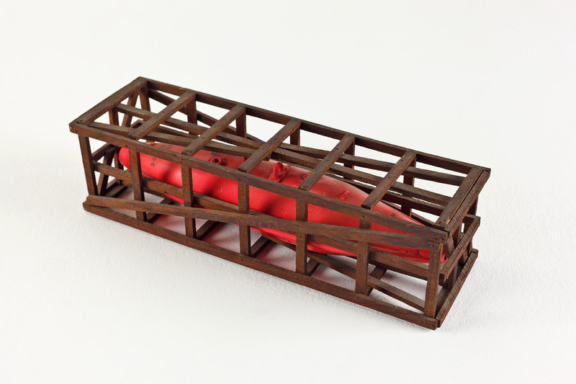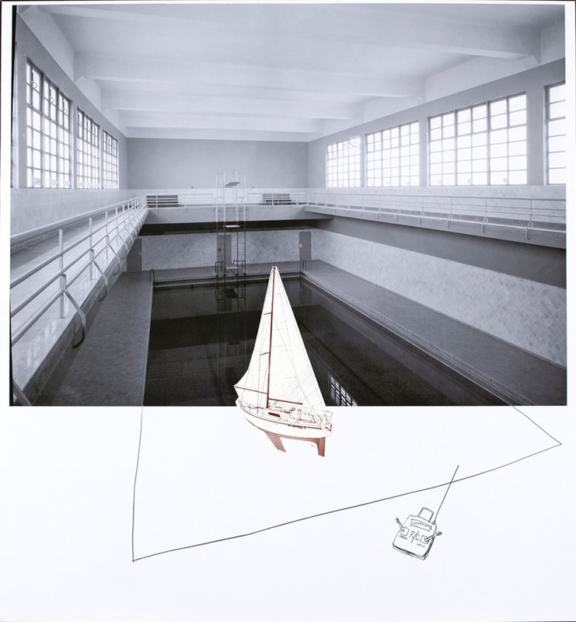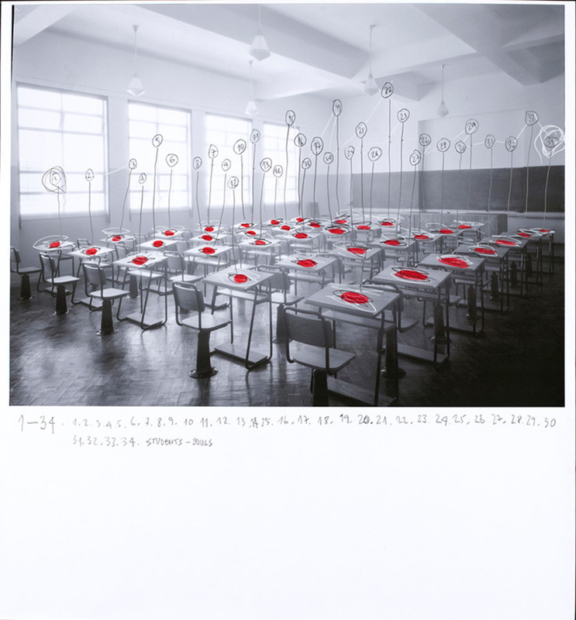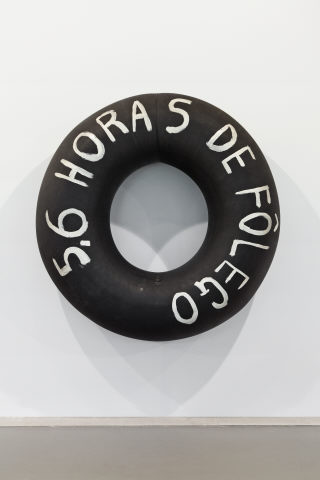
Miguel Palma
Upa! União dos Povos de Angola
Lisbon, Portugal, 1964
In 1993, together with other artists from his generation, Miguel Palma participated in the show Images for the 90s featured at the Serralves Foundation in Porto, curated by Fernando Pernes with the collaboration of António Cerveira Pinto. The exhibition also had the participation of 23 Portuguese artists, amongst whom were Daniel Blaufuks, André Gomes, João Louro, João Paulo Feliciano, Sebastião Resende, Joana Rosa, Rui Serra and João Tabarra, calling forth a rupture from the 1980s and an attempt to launch rising artists that would indeed gain prominence throughout the decade.
Proposing a critical and even ironical vision, Miguel Palma makes drawings, sculptures, installations or performance-based works as searching engines for passions and related social issues. By reinventing images or situations, Palma presents himself as maker of worlds and inventor of “ecosystems”. Ecossistema [Ecosystem] (1995) and Carbono 14 (1998) are narratives explored by the artist, whose common denominator is a focus on the creation of glass boxes where geological cuts remain visible, uncovering subterranean cities filled with situations that are perceived with irony and social criticism.
Permeated by a universe which refers to engines and machines, Miguel Palma usually works two apparently distant worlds that symbolize his passions to an almost obsessive degree. Motoring, aviation, science and engineering are areas pertaining to a universe-game that the artist ingeniously executes, working over the thin line which sometimes separates artistic production from these other domains.
Miguel Palma’s work also reflects life experiences or performative activities. This permanent duplicity in his oeuvre results in works as Engenho [Device] of 1993 – a perfectly working car executed by the artist, which he himself drove from Lisbon to Porto so as to arrive at the exhibition inauguration of Images for the 90s at the Serralves Foundation; Prova de Artista [Artist’s Proof], of 2001, in Cristina Guerra Contemporary Art Gallery, documents Miguel Palma’s participation at the National Championship of Classic Cars – obtaining the third place of the 71 Historic Cars and the first place of the G4 Class; or Projecto Gravidade [Gravity Project], 2008, where the artist executes a wheeling cart designed by himself and documented his descent by car along the Rampa do Caramulo on video. These performative works are constant situations of the interplay of pleasure and risk which Miguel Palma assumes as a challenge to himself.
Investing in his internationalization in this new millennium, Miguel Palma self-ironized such situation in 2005 with Projecto Ariete [Ariete Project], whose titles leads us on to a warlike scene (the ariete [battering ram] is an ancient war machine used to break open the gates and walls of cities under siege). Between May and June of 2005, Miguel Palma toured 16 000 km of the European continent in a Porsche 911 Carrera with an airplane cockpit adjusted on the hood. Palma visited 43 contemporary art museums and centres with the goal of showing and promoting his work. Without any previous warning, the artist, dressed in an orange Polish aviator suit, entered diverse institutions of European art with a sort of transparent missile in his hand where he kept a video, a portfolio in CD, a t-shirt, a model for a book and two helmets (a MIG helmet of Russian origin and a North-American F15 aviator helmet), thus referring to the title of his project-performance but also to the Cold War atmosphere. By subverting the relationship between artist and museums or art centres, and by denying any middleman in this relationship, Miguel Palma assumed a leading role in the project’s communication strategy which is recurrent across his work. From this odyssey have remained numerous written documents, photos and videos that were featured at an exhibition at the Cristina Guerra Gallery in 2006.
Rescue Games, created and presented in 2008 at the New Orleans Biennial of International Contemporary Art – Prospect.1 – curated by Dan Cameron, represents a sort of establishment of Miguel Palma’s internationalization project. Presenting a red Higgins boat, used in World War II, the artists carries the scale of grandeur that permeates his work to its utmost limits, in an allusive reference of temporal dimension, whose memory and connection between past and present is thus recreated. In a clear reference to the dramatic situation of the city of New Orleans devastated by hurricane Katrina in 2005, Miguel Palma uses an important rescue boat, although with a new component, by adding on its top a little motorized wave pool and a ladder that circumscribes the piece. Rescue Games is inarguably a touchstone in Miguel Palma’s oeuvre and one of his few works that were never seen in Portugal.
Miguel Palma’s artistic production gravitates between a temporality of images, that is, historical analogies, appropriation of images (maps and objects with a known date), a functional aesthetic and the capacity to reinvent metaphorical realities, sometimes placing the spectator in an uncomfortable position, leading him to question himself about situations and problematics that are close by.
IG
March 2011

Upa! União dos Povos de Angola

Técnico Miracle #12

Técnico Miracle #25

Técnico Miracle #19

Técnico Miracle #18

Técnico Miracle #10

Técnico Miracle #4

Técnico Miracle #3

Técnico Miracle #2

5,6 Horas de Fôlego

Cemiterra-Geraterra